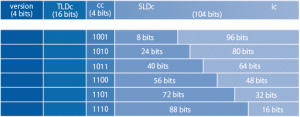As the ucode space is huge size of 2×128, it is efficiently managed by subdividing it into smaller spaces called domains. Figure 1 illustrates the ucode structure.
- There are two stages in a domain. The upper domain is called Top Level Domain (TLD) and the lower domain is called Second Level Domain (SLD).
- TLD is the domain which is allocated to the organizations approved by Ubiquitous ID Center. Organizations that manage TLD are called the TLD Management Organizations.
- SLD is the domain which is allocated to the organizations approved by the TLD Management Organizations. Organizations that manage SLD are called the SLD Management Organizations.
- The identifier of TLD is Top Level Domain Code(TLDc), and the identifier of SLD is Second Level Domain Code(SLDc). The lower area than SLDc is Identification Code (ic).
- The code to specify the boundary of SLDc and ic is called Class Code (cc). Six types of cc are currently defined with ic width of 16,32,48,64,80,or 96 bits.
- Version is the field that is set to maintain compatibility of the entire ucode system even when some changes occur to the code system in the future. Currently, the field value is 0.
ucode Management Method
Figure 2 illustrates the method for dividing ucode space.
Ubiquitous ID Center root manages the entire 128-bit code space and allocates TLDc to TLD management organizations. In this manner, the ucode version and TLDc field (upper 20 bits) managed by a TLD management organization are fixed. TLD management organizations can freely manage the following 108 bits.
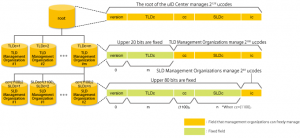
Figure 2: ucode Space Division
TLD management organizations allocate cc and SLDc to SLD management organizations. Therefore, the version, TLDc, cc, and SLDc fields of ucodes managed by an SLD management organization #2 are fixed. SLD management organizations can freely manage the following ic fields (either of 16, 32, 48, 64, 80 or 96 bits).
Lifecycle of ucode
Retrieving "information related to a ucode" by using the ucode as a key is called ucode resolution. For example, retrieving the URL (Unique Resource Locator) on the Internet where the information related to a food product is published from the ucode identifying the food product is an example of ucode resolution. A server that provides the ucode resolution function is called a "ucode resolution server" while the pair consisting of a ucode and "information associated with that ucode" maintained on the server is called a ucode resolution entry. The life cycle of a ucode starting from the unused state through the procedure of allocation and issue to actual use and destruction is defined (Figure 3). That is, there are seven states, and the procedures to change the state are stipulated in the ucode life cycle.
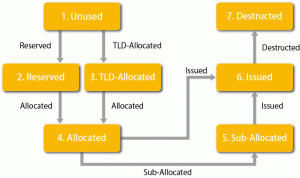
Figure 3: Lifecycle of the ucode
- Unused
The state of a ucode that has not been used yet is called the "Unused" state. This is the initial state of a ucode. - Reserved
The ucode state secured as an allocated area for a specific purpose in the future by Ubiquitous ID Center is called the "Reserved" state. The procedure to change the state of an unused ucode to the reserved state is called "Reservation." There are two methods to store ucodes in products (tags) such as RFID and infrared markers. One is storing arbitrary ucode in writable memory area, and the other is transforming unique IDs provided during shipment from the factory, which is managed by a different system from ucode, into ucode on reading (Figure 4). When ucodes are stored by the second method, the ucode reservation procedure is necessary. The ucode reservation procedure is performed when tag manufacturers apply for ucode tag certification.
Ubiquitous ID Center manages a TLDc for the ucode reservation procedure.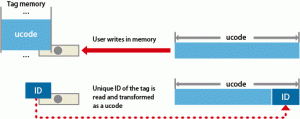
Figure 4: Method for storing ucodes in ucode tags - TLD-Allocated
Ubiquitous ID Center provides TLD management organizations with the authority to manage ucodes in a certain subspace based on an application. With this condition, the ucode state is called in "TLD-Allocated." The procedure to move ucodes in the unused state to the TLD-Allocated state is called "TLD-Allocation." - Allocated
Ubiquitous ID Center (TLD management organization) provides SLD management organizations with the authority to manage ucodes in a certain subspace based on an application. With this condition, the ucode state is called in "Allocated." The procedure to move ucodes in the TLD-Allocated or reserved state to the Allocated state is called "Allocation." When a TLD management organization allocates a ucode to an SLD management organization, the TLD management organization registers the allocated SLD management organization information in a ucode resolution server managed by the TLD management organization itself. For example, when TLD Management Organization #1 which manages the space 00001XXXXXXXXXXXXXXXXXXXXXXXXXXX (x are arbitrary) allocates the space 00001e0000000000000000000001XXXX to SLD Management Organization #1, TLD Management Organization #1 adds a ucode resolution entry "information on ucodes in the space 00001e0000000000000000000001XXXX is understood by SLD Management Organization #1" in the ucode resolution server they manage. - Sub-Allocated
When SLD management organizations may transfer the authority to issue a part of allocated ucode space to other individuals and organizations, this procedure is called Sub-allocation and the ucode state is called Sub-allocated. SLD management organizations which conduct sub-allocation are called ucode providers. - Issued
SLD management organizations or individuals and organizations to which ucodes are sub-allocated by SLD management organizations change a ucode which they have the authority to issue to a readable state, associate it with content and service, and register the relationship between the ucode and content to be associated with ucode in the ucode resolution entry. For example, SLD Management Organization #1 registers the ucode resolution entry, "information regarding the 00001e00000000000000000000011234 ucode is available at http://www.example.org/" in the ucode resolution server they manage. After this, the terminal which obtained the 00001e00000000000000000000011234 ucode will know that the information regarding this ucode is available at http://www.example.org/ by performing ucode resolution. As a result, the terminal can receive the information and service related to the obtained ucode. The ucode state in which the ucode can be used in this manner is called the Issued state and the procedure to change a ucode in the allocated or sub-allocated state to the issued state is called Issue. - Destructed
The ucode state in which a ucode not in the unused state cannot be used is called the Destructed state. The procedure to change a ucode in the issued state to the destructed state is called Destruction.
In this way, ucodes become usable after three procedures of allocation, sub-allocation, and issue. Figure 5 illustrates how ucode space is divided by each procedure of allocation, sub-allocation, and issue.
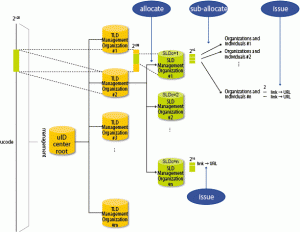
Figure 5: Relationship between ucode Allocation/Sub-allocation/Issue Procedures and ucode Space Division

